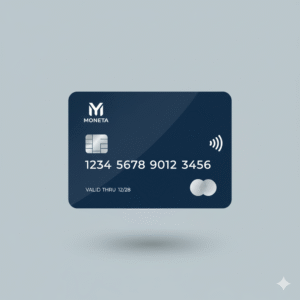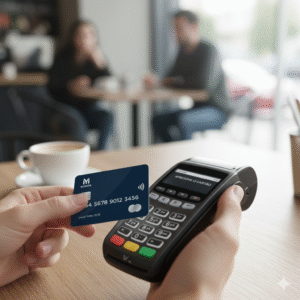How Credit Card Interest Works (and How to Avoid It)

Credit card interest, often shrouded in the confusing acronym “APR,” can feel like an unavoidable penalty of modern financial life. It’s the powerful engine that makes carrying a balance so expensive, transforming small debts into significant financial burdens over time. In fact, for millions of Americans, the high cost of credit card interest is a primary obstacle to achieving financial goals like saving for a home, investing for retirement, or simply getting out of debt.
But what if you could use a credit card for all its benefits—convenience, security, and rewards—without ever paying a single penny in interest? It’s not only possible; it’s what financially savvy people do every month.
This guide will demystify the entire concept of credit card interest. We will break down exactly what APR is, how the complex calculations work behind the scenes, and most importantly, provide a clear, actionable playbook on how to avoid these costly charges altogether. Understanding this fundamental aspect of personal finance is the key to turning your credit card from a potential liability into a powerful asset.
What is APR (Annual Percentage Rate) and Why Does It Matter?

APR, or Annual Percentage Rate, is the single most important number to understand if you ever plan to carry a balance on your credit card. In simple terms, APR is the price you pay for borrowing money from your credit card issuer. It’s expressed as a yearly rate, but don’t let the “annual” part fool you—interest isn’t charged once a year. It’s calculated far more frequently, which we’ll explore in detail later.
Why is it so important? The APR on your credit card directly determines how quickly your debt can grow. A high APR can cause your balance to snowball, making it incredibly difficult to pay off. For context, while a mortgage rate might be 7% and an auto loan 8%, the average credit card APR in the United States is currently over 20%, with some cards reaching as high as 29.99% or more. This is why credit card debt is considered one of the most expensive and dangerous types of debt.
When you look at a credit card’s terms and conditions (often in the “Schumer Box”), you’ll notice that there isn’t just one APR. Cards typically have several different types.
The Different Flavors of APR:
- Purchase APR: This is the standard interest rate applied to the purchases you make with your card. When people refer to a card’s APR, this is usually the one they mean.
- Balance Transfer APR: This is the rate applied to debt that you move from another credit card. Many cards offer an introductory 0% APR for a set period (e.g., 18 months) to encourage you to transfer your high-interest debt.
- Cash Advance APR: This rate applies when you use your credit card to withdraw cash from an ATM. It is almost always significantly higher than your purchase APR, and crucially, there is typically no grace period—interest begins to accrue the moment you receive the cash.
- Penalty APR: This is a much higher rate that the card issuer can impose if you violate the terms of your agreement, such as making a late payment or having a payment returned. The penalty APR can be extremely high and can apply to your existing balance as well as new purchases.
- Introductory APR: This is a temporary, lower (often 0%) rate offered to new cardholders on purchases and/or balance transfers for a specific promotional period.
The Secret Weapon for Avoiding Interest: Understanding Your Grace Period
The credit card grace period is the most powerful tool you have for avoiding interest charges. It is the span of time between the end of your billing cycle and your payment due date.
Here’s how it works:
- Your billing cycle is the period (usually about 30 days) during which your transactions are recorded.
- At the end of the cycle, you receive a statement with a statement balance and a payment due date.
- The time between your statement date and your payment due date is the grace period (by law, it must be at least 21 days).
If you pay your entire statement balance in full by the payment due date, you will not be charged any interest on your new purchases from that billing cycle.
This is the golden rule of responsible credit card use. People who earn hundreds or thousands of dollars in rewards each year do so by leveraging the grace period. They treat their credit card like a debit card, never charging more than they can afford to pay off in full at the end of the month.
How You Can Lose Your Grace Period:
The grace period is a privilege, not a right. If you fail to pay your statement balance in full and start to carry a balance from one month to the next, you typically lose the grace period on new purchases. This means new purchases will start accruing interest from the day they are made, making it even harder to catch up. The only way to reinstate your grace period is usually by paying your entire balance down to zero.
The Math Behind the Money: How Credit Card Interest is Calculated

So, what happens when you do carry a balance? How is that 20% APR actually applied to your account? It’s not as simple as multiplying your balance by 20% at the end of the year. Instead, interest is typically calculated daily, a method known as daily compounding.
Let’s break down the process:
Step 1: Calculate the Daily Periodic Rate (DPR)
The card issuer takes your annual APR and divides it by 365 (or 360, depending on the issuer) to get your Daily Periodic Rate.
- Formula:
APR / 365 = DPR - Example: If your APR is 21.99%, your DPR is
0.2199 / 365 = 0.000602(or about 0.06%).
Step 2: Calculate the Average Daily Balance (ADB)
The issuer doesn’t just charge interest on your final balance. They calculate the average balance you carried throughout the entire billing cycle. They add up your balance from each day of the billing cycle and then divide by the number of days in the cycle.
Step 3: Calculate the Daily Interest and Compound It
Each day, the issuer multiplies your balance for that day by the DPR to determine the interest charge. This small amount of interest is then added to your balance, and the next day, interest is calculated on the new, slightly higher balance. This is called compounding.
A Simplified Example:
Imagine you have a $1,000 balance for an entire 30-day billing cycle with a 21.99% APR.
- Daily Periodic Rate: 0.0602%
- Daily Interest Charge:
$1,000 x 0.000602 = ~$0.60 - Approximate Monthly Interest:
$0.60 x 30 days = ~$18.00
While $18 may not seem like a lot, this is how debt spirals. If you only make the minimum payment (which might be just $25-$35 on a $1,000 balance), a large portion of it goes directly to paying this interest, with very little going toward reducing the principal amount you actually owe. This is why it can take years, or even decades, to pay off credit card debt by only making minimum payments.
What is Residual Interest and How Does It Keep You in Debt?
Have you ever paid off your entire statement balance, only to find another interest charge on your next bill? This frustrating phenomenon is called residual interest (or trailing interest).
It happens when you’ve been carrying a balance. Even after you make a large payment to clear your statement balance, interest continues to accrue on a daily basis between the day your statement was issued and the day your payment was received by the bank. This leftover interest then appears on your next statement.
The only way to completely avoid residual interest is to pay your balance down to a true zero. If you’re trying to get out of debt, you may need to call your credit card company or check your online portal to get the real-time payoff amount before making your final payment.
A Step-by-Step Playbook for Avoiding Credit Card Interest

Now for the most important part: the actionable strategies to ensure you never pay these costly charges.
Strategy 1: The Pay-in-Full Method (The Gold Standard)
This is the simplest and most effective strategy.
- Treat your credit card like a debit card. Never charge more to the card than you have available in your checking account to cover the purchase.
- Set up autopay. Log in to your credit card’s online portal and set up an automatic payment to pay the full statement balance on or before the due date. This automates success and removes the risk of human error or forgetfulness.
Strategy 2: The 0% Intro APR Method (For Planned Large Purchases)
If you need to make a large purchase that you can’t pay for immediately (e.g., a new refrigerator, a laptop), a 0% introductory APR card is an excellent tool for interest-free financing.
- Find a card with a long 0% intro period on new purchases (many offer 15-21 months).
- Do the math. Divide the total purchase price by the number of months in the promotional period. For example,
$1,800 purchase / 18 months = $100 per month. - Commit to the plan. Set up automatic payments for that calculated amount to ensure the balance is paid in full before the high standard APR kicks in.
Strategy 3: The Debt Consolidation Method (For Existing Debt)
If you’re already carrying high-interest credit card debt, a balance transfer credit card can be a financial lifeline.
- Find a card with a long 0% intro period for balance transfers.
- Calculate the fee. Be aware that most cards charge a one-time balance transfer fee, typically 3% to 5% of the amount transferred. While not ideal, this fee is almost always far less than the interest you would pay on your old card.
- Stop using the old cards. Do not continue to make purchases on the cards you are paying off.
- Create an aggressive payment plan. Just like with the large purchase method, divide your total debt by the number of months in the 0% intro period and commit to paying that amount each month.
The Mindset Shift That Saves You Money
Ultimately, avoiding credit card interest requires a fundamental mindset shift. You must stop viewing your credit card’s limit as your money. It is not. It is a loan that comes with a very high price tag if you don’t follow the rules.
By understanding the mechanics of APR, respecting the power of the grace period, and committing to a strategy of paying your balance in full whenever possible, you can take control of your financial health. You can enjoy all the convenience, security, and rewards that credit cards have to offer, all while keeping your hard-earned money where it belongs: in your pocket.




